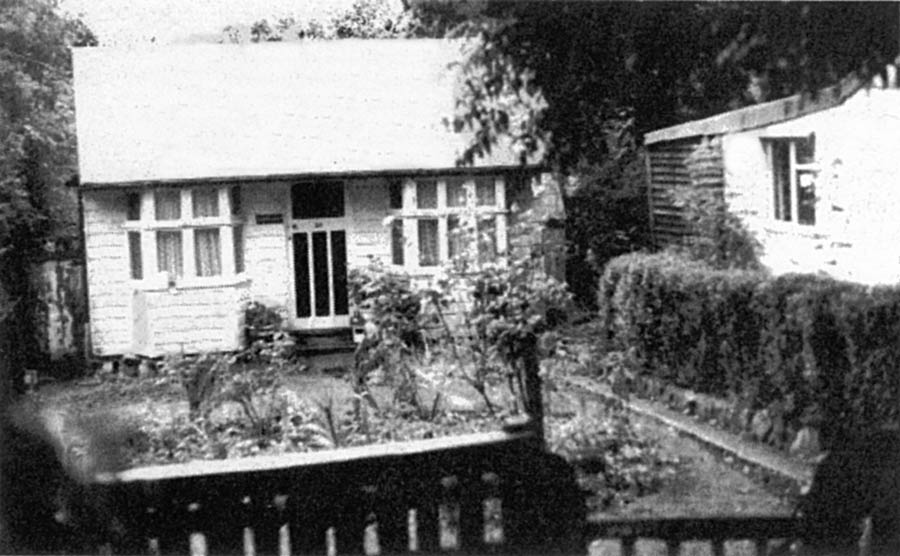
Holtsfield - A Community Under Threat
The values that most urban communities have forgotten are practised by people living in ex-holiday chalets in a community in South Wales. But their community is under threat from property developers who want to bulldoze the houses and erect a compact, maximum-profit housing estate instead. Mel Gunasena and Paul O’Connor report.
Squall 11, Autumn 1995, pg. 27.
Take a short bicycle ride away from the steel works and the polluted sea around Swansea and you may stumble across Holtsfield. Twenty seven wooden chalets, each reflecting the characters of the thirty families living in the Caswell Valley, dot 14 acres of semi-woodland in South Wales. The chalets were built in the 1920s and 30s by people who hauled the timber, by bus, from Swansea and then walked two miles with it to the building site. This is not a long-forgotten hippy commune but a diverse range of people who chose to opt out of the rat race and live a sustainable low-impact life.
One of the families has been living there for four generations and most of the children there today were born there. The oldest resident is in her nineties, whilst the latest arrival is celebrating her second month of life.
Dee Murphy has lived on “The Field” for six years with her two children; Dale, 17 and Seren, 13. She talks with a passion about the community that does not lock its doors and looks after each other. A great wooden table that sits in the middle of The Field serves as a meeting place for everything from midnight talking and drinking sessions to a forum for discussing problems.
The chalets are beautiful, built of wood and lightweight materials, with one chalet sporting a turf roof. Swansea’s skips provide the wood for room extensions and fuel for the wood stoves which supply cooking facilities, heating and hot water. Many residents use compost toilets, recycling waste onto their vegetable plots as fertilizer.
The low-impact nature of the dwellings means they do not spoil the landscape of the Gower, Britain’s first designated Area of Outstanding Natural Beauty. A stark contrast to the sea-front developments ten minutes walk away, through the woods. Ten years ago the council “improved” the beach by building a concrete and tarmac burger bar and ice-cream tourists’ paradise. Huge apartment buildings and hotels are rapidly rising on the cliff-face, ugly and monotonous.
It didn’t take developers long to discover the potential of Holtsfield. The residents of The Field own the chalets but not the land on which they stand. This was fine until, in 1989, the freehold was bought by a property development company, Elitestone Ltd, headed by a solicitor, Tim Gilbert Jones, from Swansea. His plans, made clear in a number of letters to the residents and their solicitor, are to force the residents to leave and then bulldoze their homes in order to build a housing estate. From 1990 the residents have been intimidated and told they have no legal right to remain on the land. Not only do the residents stand to lose their homes and see their community break up, they are now faced with the phenomenal costs involved in resisting Elitestone Ltd through the courts.
A Department of Environment health survey, conducted in 1991 as a result of Elitestone’s pressure and complaints, found all the chalets “unfit” for habitation, mainly on water and sewerage grounds, despite the fact that the community is healthy. Five test cases were brought before Swansea County Court, then the Court of Appeal in London, all of which were lost. In a strange twist of logic the residents are being evicted as the chalets are not seen as proper dwellings, with associated tenant’s rights, but as “temporary chalets” because they stand on concrete footings. This decision was reached by a judge in London who has never been to the Field. Not far away the residents of Tipi Valley are being evicted because their tipis are seen as permanent structures.
The few remaining hopes lie in one resident, Dai Morris, and his petition to the House of Lords for leave to appeal against these judgements. This will cost around £25,000. No-one has that kind of money, and funds, as well as morale, are getting low. Another avenue is to persuade the Council to issue a Compulsory Purchase Order to Elitestone Ltd for the land. Tim Jones paid £175,000 for the site six years ago. He is now asking for £3 million. Petitions and letters of support for Holtsfield are needed to put pressure on Swansea Council to issue the CPO.
Dee Murphy said: “We can’t believe we won’t win through in the end because we can’t bear the thought of leaving our friends and the community splitting up.” Several families are now facing eviction, and some have decided to use direct action by refusing to leave. They are emphatic that they do not want the field to turn into a full-on protest camp, but they will need the help of non-residents, especially on eviction days.
Ask for the Council's support in issuing a CPO.
Write to:
Mr A Botswain
Chief Executive
Swansea City Council
The Guildhall
Swansea
South Wales
Pledge your support for the residents of Holtsfield. Write to:
Save Holtsfield
c/o 16 Holtsfield
Murton
Swansea
SA3 3AQ
Related Articles
The Problem with Planning - Simon Fairlie argues the case for more consideration for low-impact dwellers - Squall 11, Autumn 1995.
DIY In The Sticks - Tinkers Bubble, and the difficulty of restrictive planning laws for rural communities. By Simon Fairlie - Squall 8, Autumn 1994.
Lords Back Holtsfield - residents win but developer becomes landlord. Squall 15, Summer 1997.
Chalets Shall Stay - Holtsfield community in South Wales wins right to stay. Squall 16, Summer 1998.
